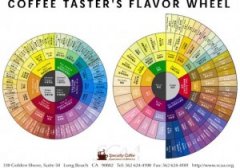The skill of blending coffee beans
Blending coffee is not a random mix of coffee beans. Sometimes the blending of two kinds of boutique coffee will suppress each other's unique flavor; blending is not simply blending several kinds of boutique coffee together. Matching is like the painter adjusting and creating charming colors in the color palette, the mixer can reconcile the attractive taste according to the different characteristics of the coffee beans. It is no exaggeration to say that matching is an art. As an artist, the assembler needs not only experience and inspiration, but also scientific calculation. The emergence of works of art will not be accidental, but the outbreak of long-term accumulation.
Since it is a blending, it naturally refers to the blending of more than two kinds of raw beans, but a special example is that it can also match the same kind of coffee beans with different roasting degrees, or even the new crop and aged coffee or old crop of the same kind of coffee beans, so the type referred to in the blending is no longer a coffee variety in a narrow sense, but extends to the flavor of coffee in a broad sense. Generally use 2 to 6 kinds of coffee beans when blending, too many kinds will not be able to show the unique flavor of coffee.

Before matching, we should be clear about the following points:
1. The theme of matching
What kind of flavor you want to match, that is, to determine the goal of the match.
two。 Understand the characteristics of each coffee bean
To mix coffee, you must first be familiar with the characteristics of each individual coffee and understand the subtle relationship between roasting and coffee flavor, all of which can only be achieved by tasting the cup.
3. Determine the task of participating in the blending of coffee beans
Since a variety of coffee beans are used together, it is necessary to know whether the task of each kind of coffee beans is to make her show soft bitterness, distinct acidity or thick mellow taste, etc.
Generally speaking, the following principles should be followed when matching:
1. Blending of raw beans requires the use of coffee beans with their own characteristics, and avoid using coffee beans with similar flavor. The choice of raw beans can be considered from three aspects:
Raw bean treatment method: that is, whether raw beans are treated by washing method or drying method, which has a lot to do with the flavor of coffee beans.
Producing areas of raw beans: coffee producing areas are generally divided into three major regions, including about 20 countries in Central and South America, namely, Brazil, Colombia, Guatemala, Mexico, Delvado, Jamaica and Peru, and about 10 countries in Southeast Asia, namely India, Indonesia (including Java and Sumatra) and Papua New Guinea. About 25 countries in the Arab and African regions, namely, Ethiopia, Kenya, Tanzania, Arabia, Uganda and so on.
Coffee bean flavor: refers to the coffee bean flavor of sour, bitter, sweet, alcohol which is more prominent, or all aspects of more balanced neutral beans. Now the most commonly used raw beans are Brazil, Colombia and Mocha.
two。 The number and proportion of coffee beans involved in blending
Since it is a blending, it naturally refers to the blending of more than two kinds of raw beans, but a special example is that it can also match the same kind of coffee beans with different roasting degrees, or even the new crop and aged coffee or old crop of the same kind of coffee beans, so the type referred to in the blending is no longer a coffee variety in a narrow sense, but extends to the flavor of coffee in a broad sense. Generally use 2 to 6 kinds of coffee beans when blending, too many kinds will not be able to show the unique flavor of coffee. Blended coffee usually does not take the 1:1 blending ratio, because this may suppress each other's unique flavor, so the blending must be primary and secondary in order to produce a better taste than a single coffee. If you want the coffee to taste complex and changeable, you can reduce the proportion of raw beans, and vice versa.
3. The blending of coffee depends on constant attempts, so a blending schedule should be drawn up mathematically before blending, and then the best plan should be determined through the process of blending-tasting cups. Don't think that this is a negative and stupid approach. In fact, a good cup of coffee can only be made by the experience, inspiration and tireless attempt of the blender.
Important Notice :
前街咖啡 FrontStreet Coffee has moved to new addredd:
FrontStreet Coffee Address: 315,Donghua East Road,GuangZhou
Tel:020 38364473
- Prev

Tell me about the coffee flavor wheel.
Friends who love boutique coffee should be no stranger to this SCAA flavor wheel, but many say they don't understand it, so let's briefly talk about the structure and expression of flavor wheel today! The flavor wheel is divided into the negative flavor spectrum on the left and the normal flavor spectrum on the right. First, let's talk about the right half of the flavor spectrum. This part is mainly about the classification and formation of coffee flavor and aroma enzymatic.
- Next

Basic exercise of flower drawing-leaves
When the flower drawing step is merged to seven minutes full, put the milk pot close to the coffee surface and see that when the milk foam is formed on the coffee surface, you begin to shake the milk pot while shaking the steel cup while pulling the milk pot back almost full, stop shaking, and raise the milk pot to push the milk pot forward to form a tip.
Related
- Beginners will see the "Coffee pull flower" guide!
- What is the difference between ice blog purified milk and ordinary milk coffee?
- Why is the Philippines the largest producer of crops in Liberia?
- For coffee extraction, should the fine powder be retained?
- How does extracted espresso fill pressed powder? How much strength does it take to press the powder?
- How to make jasmine cold extract coffee? Is the jasmine + latte good?
- Will this little toy really make the coffee taste better? How does Lily Drip affect coffee extraction?
- Will the action of slapping the filter cup also affect coffee extraction?
- What's the difference between powder-to-water ratio and powder-to-liquid ratio?
- What is the Ethiopian local species? What does it have to do with Heirloom native species?

